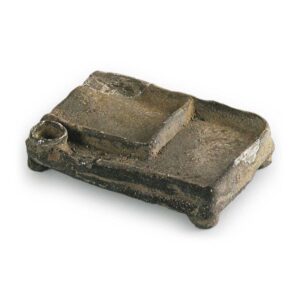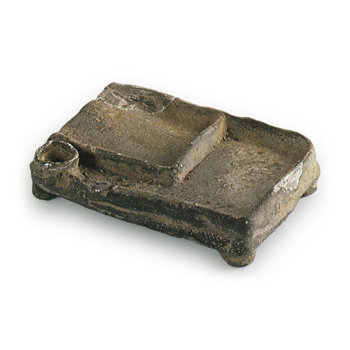
Ceramic inkstones have been used in Japan, China, and Korea since ancient times, but there is no denying that they are inferior to jade stones. The “Tao Xue” quotes from the “Inkstone History” by Ye Yuan Chang of Song Dynasty China: “In the Chen Wenhui family, there is an inkstone made of pottery from the reign of a Shu king, with a phoenix on the lid, sitting on a stand. The Tuanzhu Shuikeng inkstone is the noblest of all, but the jade, crystal, and gold inkstones are second only to the clear mud, It has a brownish color, and its heart is like silver, and the water that returns to it is like that of a fed-up Yong. It has a wavy pattern underneath, and there is no oil on the part near the feet or where the ink is polished. In the “History” by Wang De-Shin of the Song Dynasty, we read, “Guo Yu-Je obtained a piece of pottery with a round, white body and a hollow diameter of 67cm. The inkstone from the Gorin Geko kiln is inscribed in the Aesho Tei Shu by Zhu Yizon of the Qing Dynasty: “The clear mud of the pavilion and the tiles of the palace are not yet old and elegant, and the green spring waves are not wetted by the stone. There are about 20 ceramic inkstones shown in the “Wakan Kenpu,” and the Kumano Shrine’s treasured Sarukyogen inkstone is said to have been used by Ono Dofu and Fujiwara no Yukinari. The porcelain inkstone in the Todaiji Temple is said to have been used by the priest Ryoben, and the blue and white porcelain round inkstone in the Domyoji Tenmangu Shrine is said to have been used by Sugawara no Michizane. In China, ceramic inkstones seem to have been used since the Sui and Tang dynasties, and relics of northern celadon and Yuezhou celadon can be found in China. In Japan, the production of inkstone and stoneware dates back to the 7th century. In recent years, a large number of ceramic inkstones have been found at the Tōeup ancient kiln complex and other Sue ware kiln sites around the country. Most of the Japanese ceramic inkstones are round-faced inkstones or wind character inkstones, and in the case of round-faced inkstones, there are many variations in the decoration of the pedestal. Generally speaking, older round-faced inkstones have a deeper “sea” section around the edge of the inkstone, which gradually becomes shallower as the age of the inkstone progresses, and eventually the gap between the “sea” and “land” sections becomes almost impossible to distinguish. In the Nara period (710-794), the shapes of ceramic inkstones became more diverse, and special examples such as the Hoshu inkstone and the bird-shaped inkstone have been found at the Heijo Palace site and elsewhere. In the Nara period, sutra copyists and low-ranking officials used Sue ware cup covers to make inkstones. The use of ceramic inkstones continued to flourish into the Heian period (794-1185), but stone inkstones gradually became popular in the Fujiwara period (794-1185), and by the end of the Heian period, ceramic inkstones had almost completely disappeared.



